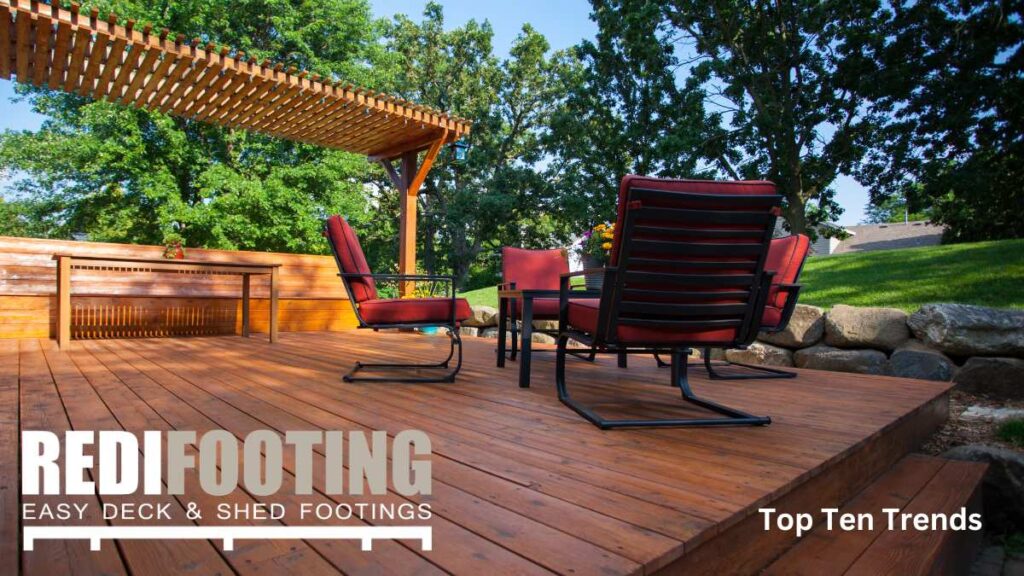Top 10 Deck Design Trends
Decks have always been more than just an additional wood structure off the back of a house. As an extension of our indoor living spaces, a deck provides a seamless transition to the fresh air of the outdoors. New trends and building processes are shaping how decks are designed, built, and enjoyed. Whether you’re planning a new build or looking to update an existing deck, these top 10 trends will inspire you to create and enjoy your outdoor living space that’s both stylish and functional.
1. Multi-Level Decks
Decks don’t have to be confined to a single plane. Multi-level decks are gaining popularity, offering distinct areas for dining, lounging, and even gardening. These designs make the most of uneven terrain and can add a dynamic, architectural element to your outdoor space. Whether you have a sprawling yard or a more compact area, multi-level decks create visual interest and maximize the usability of your space.
2. Sustainable Materials
Sustainability continues to be a major influence in deck design. Homeowners are increasingly choosing eco-friendly materials like composite decking made from recycled wood fibers and plastics, or sustainably sourced natural wood like bamboo. These materials not only reduce environmental impact but also offer durability and low maintenance, making them a smart investment for the future.
3. Outdoor Kitchens and Dining Areas
As the trend of outdoor living continues, the demand for outdoor kitchens and dining spaces on decks is soaring. Expect to see fully equipped kitchens with grills, sinks, refrigerators, and even pizza ovens integrated into deck designs. Paired with comfortable dining furniture and weather-resistant cabinetry, these spaces are perfect for entertaining family and friends while enjoying the fresh air.
4. Mixed-Material Designs
Combining different materials is a trend that adds texture and visual appeal to decks. Think wood paired with metal, stone, or concrete elements. For example, you might see a wooden deck with metal railings, or a concrete seating area embedded into a wooden deck. This trend allows for creative expression and can make your deck stand out while blending harmoniously with the rest of your outdoor space.
5. Integrated Lighting
Lighting is no longer an afterthought in deck design. This year, integrated lighting is a key feature, enhancing both the functionality and ambiance of outdoor spaces. LED strip lights, recessed lighting, and solar-powered fixtures can be seamlessly incorporated into stairs, railings, and under-deck areas. These lights not only provide safety but also create a warm, inviting atmosphere for evening gatherings.
6. Minimalist Aesthetics
Clean lines, simple forms, and uncluttered spaces define the minimalist trend in deck design. Homeowners are opting for sleek, modern designs with a focus on functionality and elegance. This trend often features neutral color palettes, with natural wood tones or muted grays dominating the scene. The result is a sophisticated, timeless look that complements any home style.
7. Vertical Gardens and Green Walls
As outdoor spaces become more integrated with nature, vertical gardens and green walls are becoming popular additions to deck designs. These living walls not only add a lush, vibrant touch to your deck but also provide privacy and help reduce noise. They are perfect for small spaces where traditional gardening might not be feasible, offering a way to bring nature closer to your living area.
8. Built-In Seating and Storage
Efficiency and comfort are key in today’s deck design, with built-in seating and storage solutions leading the way. Benches with storage compartments, under-deck cabinets, and integrated planters are practical additions that help keep the deck clutter-free while providing ample seating for guests. These features are especially useful for smaller decks, where maximizing space is essential.
9. Fire Features
Fire features are set to be a hot trend this year, quite literally. Fire pits, fireplaces, and fire tables are becoming focal points on decks, providing warmth and ambiance for outdoor gatherings. These features can be fueled by wood, propane, or natural gas, and they add a cozy element to your deck, making it usable even on cooler nights. Whether you prefer a modern gas fireplace or a rustic wood-burning fire pit, there’s a fire feature to suit every style.
However, with the charm of fire comes the responsibility to ensure safety. When incorporating a fire feature on your deck, it’s crucial to follow safety guidelines to prevent accidents. Always ensure that your fire pit or fireplace is placed on a non-combustible surface, such as stone or concrete, and keep it a safe distance from any flammable materials like wood railings or furniture. Installing a fire-resistant barrier around the fire feature is also a good practice.
Proper ventilation is essential, especially for gas-fueled fire features, to prevent the buildup of dangerous fumes. Additionally, always have a fire extinguisher or a bucket of sand nearby, and never leave a fire unattended. By taking these precautions, you can enjoy the warmth and beauty of a fire feature while keeping your deck safe for everyone.
10. Smart Technology Integration
The rise of smart home technology is extending to outdoor spaces, with more homeowners incorporating tech features into their deck designs. From smart lighting systems that can be controlled via smartphone to weather sensors that protect outdoor furniture, technology is making decks more convenient and enjoyable. You can even install speakers, automated awnings, or misting systems to enhance your outdoor experience, all controlled with the touch of a button.
Conclusion
Deck design today is all about creating versatile, stylish, and functional outdoor spaces that enhance your lifestyle. Whether you’re drawn to the clean lines of minimalist aesthetics, the warmth of fire features, or the practicality of built-in seating, these trends offer something for every taste and budget. As you plan your deck, consider incorporating these ideas to create a space that’s not only beautiful but also perfectly suited to your needs.


